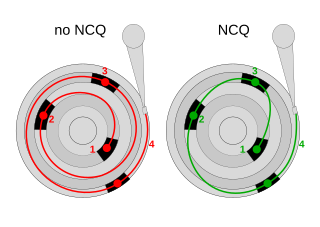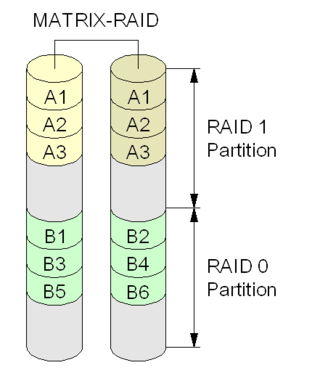
Parallel ATA (PATA), originally AT Attachment, also known as Integrated Drive Electronics (IDE), is a standard interface designed for IBM PC-compatible computers. It was first developed by Western Digital and Compaq in 1986 for compatible hard drives and CD or DVD drives. The connection is used for storage devices such as hard disk drives, floppy disk drives, optical disc drives, and tape drives in computers.
Advanced power management (APM) is a technical standard for power management developed by Intel and Microsoft and released in 1992 which enables an operating system running an IBM-compatible personal computer to work with the BIOS to achieve power management.

SATA is a computer bus interface that connects host bus adapters to mass storage devices such as hard disk drives, optical drives, and solid-state drives. Serial ATA succeeded the earlier Parallel ATA (PATA) standard to become the predominant interface for storage devices.

CompactFlash (CF) is a flash memory mass storage device used mainly in portable electronic devices. The format was specified and the devices were first manufactured by SanDisk in 1994.
A disk array controller is a device that manages the physical disk drives and presents them to the computer as logical units. It almost always implements hardware RAID, thus it is sometimes referred to as RAID controller. It also often provides additional disk cache.

Clariion is a discontinued SAN disk array manufactured and sold by EMC Corporation, it occupied the entry-level and mid-range of EMC's SAN disk array products. In 2011, EMC introduced the EMC VNX Series, designed to replace both the Clariion and Celerra products.

In computing, Native Command Queuing (NCQ) is an extension of the Serial ATA protocol allowing hard disk drives to internally optimize the order in which received read and write commands are executed. This can reduce the amount of unnecessary drive head movement, resulting in increased performance for workloads where multiple simultaneous read/write requests are outstanding, most often occurring in server-type applications.
The Advanced Host Controller Interface (AHCI) is a technical standard defined by Intel that specifies the register-level interface of Serial ATA (SATA) host controllers in a non-implementation-specific manner in its motherboard chipsets.

A solid-state drive (SSD) is a type of solid-state storage device that uses integrated circuits to store data persistently. It is sometimes called semiconductor storage device, solid-state device, or solid-state disk.
The AMD 700 chipset series is a set of chipsets designed by ATI for AMD Phenom processors to be sold under the AMD brand. Several members were launched in the end of 2007 and the first half of 2008, others launched throughout the rest of 2008.
I/O Controller Hub (ICH) is a family of Intel southbridge microchips used to manage data communications between a CPU and a motherboard, specifically Intel chipsets based on the Intel Hub Architecture. It is designed to be paired with a second support chip known as a northbridge. As with any other southbridge, the ICH is used to connect and control peripheral devices.
Spin-up refers to the process of a hard disk drive or optical disc drive accelerating its platters or inserted optical disc from a stopped state to an operational speed. The required operational speed depends on the design of the disk drive. Typical speeds of hard disks have been 2400, 3600, 4200, 5400, 7200, 10000 and 15000 revolutions per minute (RPM). Achieving such speeds can require a significant portion of the available power budget of a computer system, and so application of power to the disks must be carefully controlled. Operational speed of optical disc drives may vary depending on type of disc and mode of operation.

Intel Rapid Storage Technology (RST) is a driver SATA AHCI and a firmware-based RAID solution built into a wide range of Intel chipsets. Currently also is installed as a driver for Intel Optane temporary storage units.
A trim command allows an operating system to inform a solid-state drive (SSD) which blocks of data are no longer considered to be "in use" and therefore can be erased internally.
The Intel X79 is a Platform Controller Hub (PCH) designed and manufactured by Intel for their LGA 2011 and LGA 2011-1.

The Intel X25-M was a line of Serial ATA interface solid-state drives developed by Intel for personal computers, announced in late 2008. The SSD was a multi-level-cell solid-state drive available in a 2.5" form factor, came in 80 GB and 160 GB capacities and utilized NAND flash memory on a 50 nm process. The second-generation SSD which was called the "X25-M G2". The X25-M G2 was also available in a 2.5" form factor and 80 GB and 160 GB capacities, but with NAND flash memory on a more efficient 34 nm process.
NVM Express (NVMe) or Non-Volatile Memory Host Controller Interface Specification (NVMHCIS) is an open, logical-device interface specification for accessing a computer's non-volatile storage media usually attached via the PCI Express bus. The initial NVM stands for non-volatile memory, which is often NAND flash memory that comes in several physical form factors, including solid-state drives (SSDs), PCIe add-in cards, and M.2 cards, the successor to mSATA cards. NVM Express, as a logical-device interface, has been designed to capitalize on the low latency and internal parallelism of solid-state storage devices.

M.2, pronounced m dot two and formerly known as the Next Generation Form Factor (NGFF), is a specification for internally mounted computer expansion cards and associated connectors. M.2 replaces the Mini SATA (mSATA) standard and the Mini PCIe (mPCIe) standard. Employing a more flexible physical specification, M.2 allows different module widths and lengths, which, paired with the availability of more advanced interfacing features, makes M.2 more suitable than mSATA in general for solid-state storage applications, particularly in smaller devices such as ultrabooks and tablets.

SATA Express is a computer bus interface that supports both Serial ATA (SATA) and PCI Express (PCIe) storage devices, initially standardized in the SATA 3.2 specification. The SATA Express connector used on the host side is backward compatible with the standard SATA data connector, while it also provides two PCI Express lanes as a pure PCI Express connection to the storage device.
Intel X99, codenamed "Wellsburg", is a Platform Controller Hub (PCH) designed and manufactured by Intel, targeted at the high-end desktop (HEDT) and enthusiast segments of the Intel product lineup. The X99 chipset supports both Intel Core i7 Extreme and Intel Xeon E5-16xx v3 and E5-26xx v3 processors, which belong to the Haswell-E and Haswell-EP variants of the Haswell microarchitecture, respectively. All supported processors use the LGA 2011-v3 socket.









